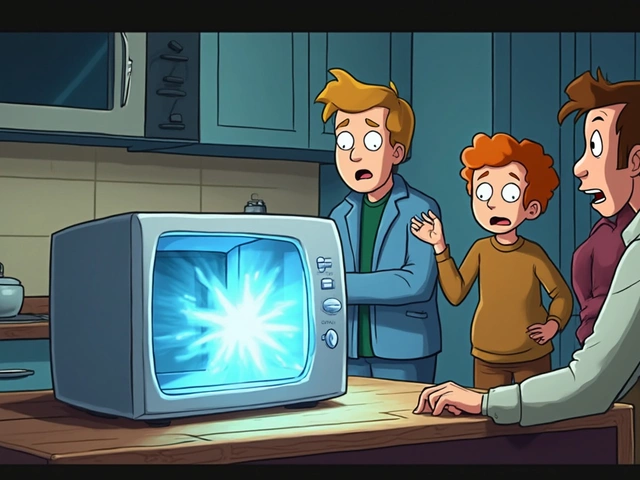Ever noticed your microwave acting weird? Strange noises, longer cooking times, or even odd smells? Yep, these could be signs that your microwave is throwing in the towel. Crazy, right? But don't stress, I'm here to help you spot these pesky problems before they become a major headache.
Let's start with those strange noises. If your microwave is suddenly sounding like it's hosting a heavy metal concert, that's a big red flag. Usually, it's one of the first signs something's up. It might just be a faulty turntable motor or, on the worse side, a problem with the magnetron, which is basically the guts of the microwave.
Inconsistent heating is another classic sign. Ever noticed your leftovers are warm on the outside but cold in the middle? Yikes, that's frustrating. It could be your microwave's way of telling you it’s struggling with power delivery. Either way, it's not something to ignore.
Strange Noises
Okay, so your microwave is suddenly louder than a rock concert. Don’t panic, but don’t ignore it either. Strange noises are a solid clue that something isn't right under the hood. Generally, these noises are tied to a few microwave components that you might want to check out.
Rattling or Grinding
Hearing something that sounds like a pile of rocks in a washing machine? The usual suspect is the turntable motor. It could be struggling to move smoothly, maybe because of a worn-out gear. You might also want to check the roller ring—it might just be a simple matter of something caught under there.
Buzzing or Humming
A loud buzzing sound might mean the magnetron, the heart of your microwave, is having trouble. This could be serious since the magnetron generates those microwaves that heat the food. If it's the culprit, you might need to consider repairs or a replacement. Also, make sure there are no metal objects like foil or utensils inside, as they can also cause havoc.
Clicking or Beeping
Now, if your microwave keeps making random clicking or beeping sounds, this could be due to an electrical issue. Maybe a door switch isn't closing properly, which can be a common cause since microwaves need tightly sealed doors to function safely.
So, before you call a repair guy, here's a tip: try unplugging your microwave for a few minutes to reset it. If the noise persists, it might be time for professional help or even considering whether it's cheaper to invest in a new one altogether.
Inconsistent Heating
If your microwave is heating food unevenly, it could be hinting at a deeper problem. You might pop in a bowl expecting it to be steamy all over, only to find hot and cold patches instead. This kind of flawed performance in microwave repair isn't uncommon, but it can be a real hassle.
Possible Causes
One reason for this could be a worn-out magnetron. This component is responsible for generating the microwaves that actually cook your food. When it starts weakening, the microwave might not distribute heat evenly.
Another potential issue could be with the diode. The diode works with the capacitor to deliver the correct power level. If it's damaged, it can mess with the microwave's heating ability, leading to cold spots.
What To Do
- First, try a simple test. Place a cup of water in the center of the microwave. Heat it for one minute. It should be uniformly hot. If it isn’t, there’s an issue.
- Check the roller guide and the coupler (the little part that fits into the bottom of your microwave). If they’re not aligned or dirty, they could be affecting the way your food rotates and heats.
- If you've ruled out these issues, consider reaching out to an appliance maintenance specialist. Having a pro look at it could save you time and frustration in the long run.
The key is not to ignore these symptoms. Regular appliance maintenance can keep your microwave running smoothly and extend its lifespan. Plus, catching small problems before they turn into big ones can save you from having to replace your faulty microwave unexpectedly.

Unusual Smells
So, your microwave is working hard, and all of a sudden - bam! You're hit with a smell that doesn't quite match your meal vibes. If your trusty appliance is putting out a strange and persistent odor, it’s time to take notice. This isn't just about burnt popcorn funk lingering; we're talking mystery smells that don’t seem to fade.
First off, if you catch a whiff of something like melted plastic or burning wires, unplug your microwave right away. Such odors can hint at serious internal issues like wiring problems or a component failure. And trust me, you don't want to ignore these, as they can lead swiftly to more significant problems or even safety hazards.
Now, if it's more of a musty or damp smell, it might not be as urgent. However, it's a sign your microwave needs a little TLC. This can be caused by food particles and grease buildup, often in older or frequently used microwaves. Regular cleaning inside the oven cavity and vent areas are essential to prevent such smells from escalating.
Preventive Steps
- Check and clean the interior after every use. Sticky spills can sneakily solidify and start smelling funky.
- Ensure the ventilation system isn’t blocked. Blocked vents can cause overheating and burning smells.
- Use covers when microwaving food, which helps keep the inside cleaner and less prone to lingering odors.
Microwave repair becomes less daunting when you know what you're up against. Taking these smells seriously and acting fast can help keep your kitchen smelling fresh and your appliance running smoothly.
Physical Damage
Alright, so let’s talk about the kind of damage you can easily spot with the naked eye. It's the stuff that screams 'Hey, look at me, fix me or toss me!' One of the easiest signs that your microwave might be checking out is physical damage. We're talking obvious problems like cracks, dents, and even door alignment issues.
Cracks and Dents
If your microwave is showing off some new cracks or dents, those aren't just cosmetic issues. Cracks in the door or in the casing can let out microwave radiation which, let’s face it, no one wants in their kitchen. Plus, dents can affect the internal components, leading to even bigger problems down the line.
Door Issues
Now let’s move on to the door. The door isn't just there to keep the heat in. It's a safety feature in itself. If the door isn't closing properly or if it’s misaligned, it might not be sealing correctly. That’s a big deal because the microwave won't function properly and it could be dangerous.
Control Panel Problems
Another thing to keep an eye on is the control panel. If buttons are sticking, missing, or not responding, it might not just be a minor annoyance. A faulty control panel can lead to incorrect settings being applied, which means your food won't be cooked evenly, or worse, it might overheat.
Burn Marks and Smoke
Got burn marks or noticed smoke spots? Alright, that's a pretty loud alarm bell. Not only does this indicate something's gone seriously wrong in the past, but it also suggests potential fire hazards. If you ever see smoke—or even just soot—during or after use, that microwave needs immediate attention.
Beyond these visible signs, it's important to remember that physical damage might be covering up internal issues. If you spot any of these problems, consider reaching out to a trusted microwave repair service or thinking about getting a new microwave altogether, because safety first, folks! Plus, a bad appliance maintenance habit can end up costing more.




